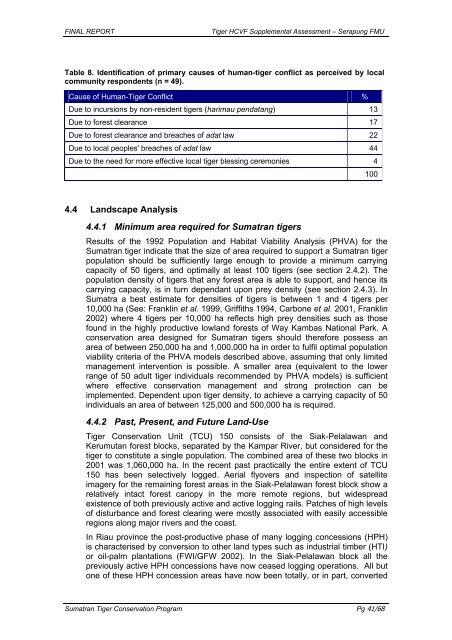A Supplemental HCVF Assessment on the Sumatran Tiger ...
A Supplemental HCVF Assessment on the Sumatran Tiger ...
A Supplemental HCVF Assessment on the Sumatran Tiger ...
Create successful ePaper yourself
Turn your PDF publications into a flip-book with our unique Google optimized e-Paper software.
FINAL REPORT <strong>Tiger</strong> <str<strong>on</strong>g>HCVF</str<strong>on</strong>g> <str<strong>on</strong>g>Supplemental</str<strong>on</strong>g> <str<strong>on</strong>g>Assessment</str<strong>on</strong>g> – Serapung FMU<br />
Table 8. Identificati<strong>on</strong> of primary causes of human-tiger c<strong>on</strong>flict as perceived by local<br />
community resp<strong>on</strong>dents (n = 49).<br />
Cause of Human-<strong>Tiger</strong> C<strong>on</strong>flict %<br />
Due to incursi<strong>on</strong>s by n<strong>on</strong>-resident tigers (harimau pendatang) 13<br />
Due to forest clearance 17<br />
Due to forest clearance and breaches of adat law 22<br />
Due to local peoples' breaches of adat law 44<br />
Due to <strong>the</strong> need for more effective local tiger blessing cerem<strong>on</strong>ies 4<br />
4.4 Landscape Analysis<br />
4.4.1 Minimum area required for <strong>Sumatran</strong> tigers<br />
Results of <strong>the</strong> 1992 Populati<strong>on</strong> and Habitat Viability Analysis (PHVA) for <strong>the</strong><br />
<strong>Sumatran</strong> tiger indicate that <strong>the</strong> size of area required to support a <strong>Sumatran</strong> tiger<br />
populati<strong>on</strong> should be sufficiently large enough to provide a minimum carrying<br />
capacity of 50 tigers, and optimally at least 100 tigers (see secti<strong>on</strong> 2.4.2). The<br />
populati<strong>on</strong> density of tigers that any forest area is able to support, and hence its<br />
carrying capacity, is in turn dependant up<strong>on</strong> prey density (see secti<strong>on</strong> 2.4.3). In<br />
Sumatra a best estimate for densities of tigers is between 1 and 4 tigers per<br />
10,000 ha (See: Franklin et al. 1999, Griffiths 1994, Carb<strong>on</strong>e et al. 2001, Franklin<br />
2002) where 4 tigers per 10,000 ha reflects high prey densities such as those<br />
found in <strong>the</strong> highly productive lowland forests of Way Kambas Nati<strong>on</strong>al Park. A<br />
c<strong>on</strong>servati<strong>on</strong> area designed for <strong>Sumatran</strong> tigers should <strong>the</strong>refore possess an<br />
area of between 250,000 ha and 1,000,000 ha in order to fulfil optimal populati<strong>on</strong><br />
viability criteria of <strong>the</strong> PHVA models described above, assuming that <strong>on</strong>ly limited<br />
management interventi<strong>on</strong> is possible. A smaller area (equivalent to <strong>the</strong> lower<br />
range of 50 adult tiger individuals recommended by PHVA models) is sufficient<br />
where effective c<strong>on</strong>servati<strong>on</strong> management and str<strong>on</strong>g protecti<strong>on</strong> can be<br />
implemented. Dependent up<strong>on</strong> tiger density, to achieve a carrying capacity of 50<br />
individuals an area of between 125,000 and 500,000 ha is required.<br />
4.4.2 Past, Present, and Future Land-Use<br />
<strong>Tiger</strong> C<strong>on</strong>servati<strong>on</strong> Unit (TCU) 150 c<strong>on</strong>sists of <strong>the</strong> Siak-Pelalawan and<br />
Kerumutan forest blocks, separated by <strong>the</strong> Kampar River, but c<strong>on</strong>sidered for <strong>the</strong><br />
tiger to c<strong>on</strong>stitute a single populati<strong>on</strong>. The combined area of <strong>the</strong>se two blocks in<br />
2001 was 1,060,000 ha. In <strong>the</strong> recent past practically <strong>the</strong> entire extent of TCU<br />
150 has been selectively logged. Aerial flyovers and inspecti<strong>on</strong> of satellite<br />
imagery for <strong>the</strong> remaining forest areas in <strong>the</strong> Siak-Pelalawan forest block show a<br />
relatively intact forest canopy in <strong>the</strong> more remote regi<strong>on</strong>s, but widespread<br />
existence of both previously active and active logging rails. Patches of high levels<br />
of disturbance and forest clearing were mostly associated with easily accessible<br />
regi<strong>on</strong>s al<strong>on</strong>g major rivers and <strong>the</strong> coast.<br />
In Riau province <strong>the</strong> post-productive phase of many logging c<strong>on</strong>cessi<strong>on</strong>s (HPH)<br />
is characterised by c<strong>on</strong>versi<strong>on</strong> to o<strong>the</strong>r land types such as industrial timber (HTI)<br />
or oil-palm plantati<strong>on</strong>s (FWI/GFW 2002). In <strong>the</strong> Siak-Pelalawan block all <strong>the</strong><br />
previously active HPH c<strong>on</strong>cessi<strong>on</strong>s have now ceased logging operati<strong>on</strong>s. All but<br />
<strong>on</strong>e of <strong>the</strong>se HPH c<strong>on</strong>cessi<strong>on</strong> areas have now been totally, or in part, c<strong>on</strong>verted<br />
<strong>Sumatran</strong> <strong>Tiger</strong> C<strong>on</strong>servati<strong>on</strong> Program Pg 41/68<br />
100

















